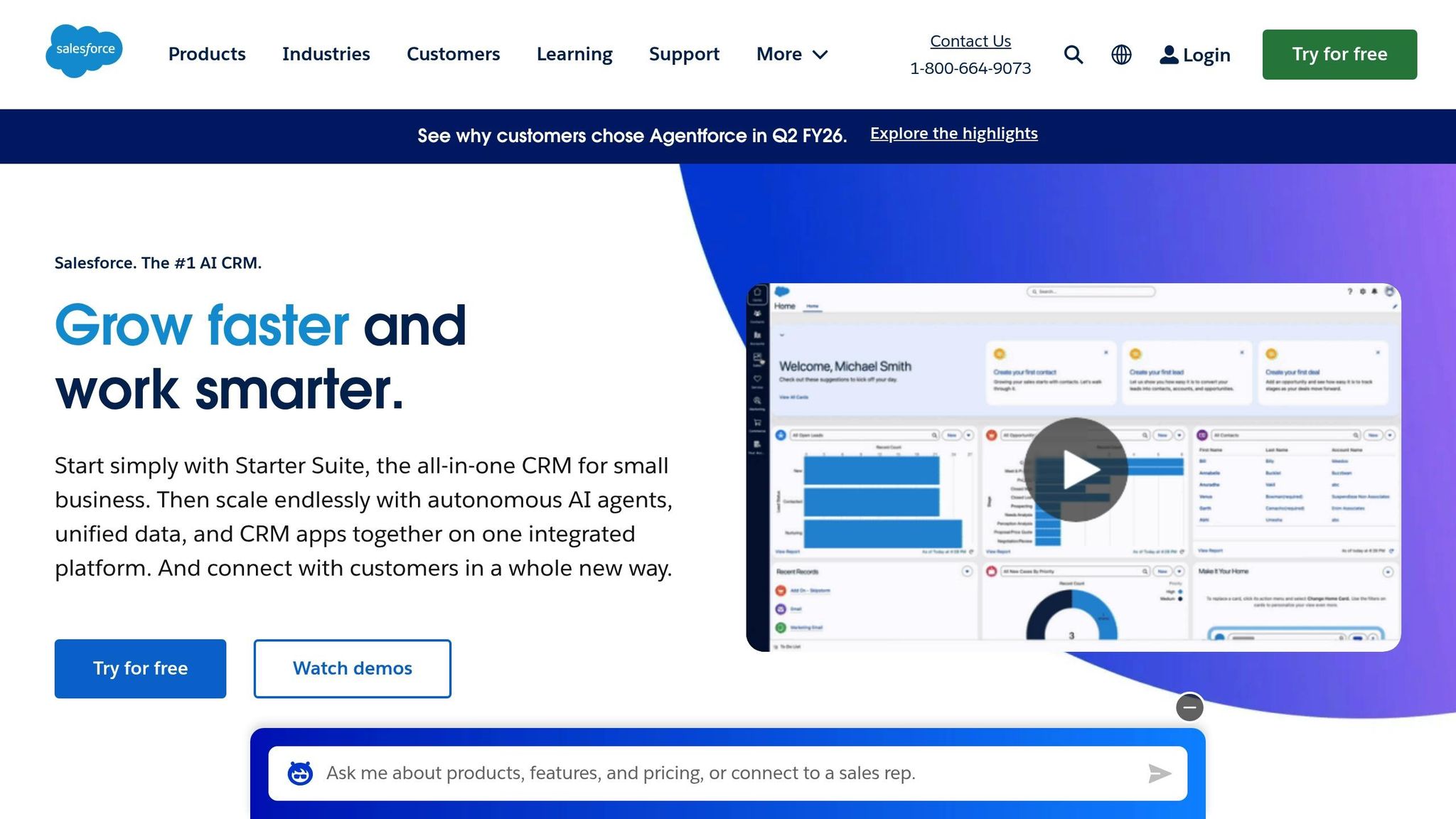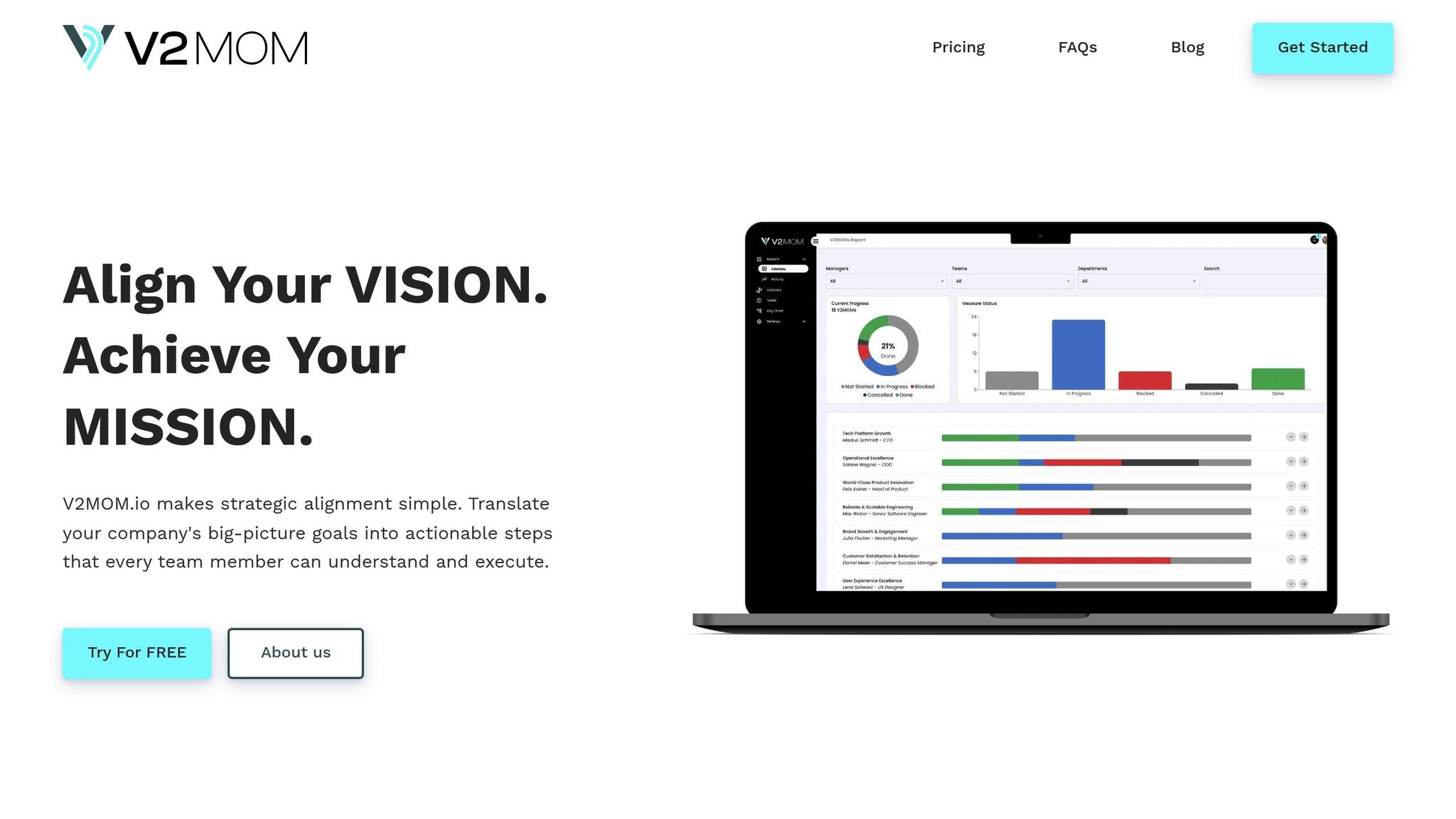Data analytics transforms V2MOM from a static framework into a dynamic tool for achieving business goals. V2MOM, created by Salesforce CEO Marc Benioff, focuses on Vision, Values, Methods, Obstacles, and Measures. When combined with analytics, it helps businesses make evidence-based decisions, track progress, and refine strategies in real-time. Here’s why this matters:
- Clarity: Analytics ensures goals are realistic and measurable, eliminating guesswork.
- Goal Tracking: Data-driven KPIs help monitor success at every level.
- Problem Solving: Analytics identifies obstacles and tests solutions effectively.
- Team Alignment: Shared metrics break silos and unite departments.
For U.S. businesses, where proving results is a must, integrating analytics into V2MOM drives better decision-making and accountability. Tools like V2MOM.io simplify this by offering centralized dashboards, built-in analytics, and real-time updates, starting at $5.99 per user/month. This approach ensures every team member understands their role in achieving the company's vision.
V2MOM: The Salesforce Management Process | Vision, Values, Methods, Obstacles, Measures

How Data Analytics Drives V2MOM Success
Blending data analytics with the V2MOM framework helps organizations achieve measurable progress, foster continuous improvement, and ensure accountability.
Enhancing Strategic Clarity
Data analytics turns V2MOM into more than just a planning tool - it becomes a driver of strategic alignment. By using concrete data to validate the feasibility of a vision, analytics ensures that strategic goals are rooted in reality. This approach shifts decision-making from guesswork to evidence-based strategies, providing a solid foundation for tactical actions.
With data-driven insights, success criteria become standardized, removing room for subjective interpretations. This clarity allows teams to fine-tune their strategies based on measurable performance indicators. Analytics also enables teams to test different approaches, measure their effectiveness, and adjust when results fall short of expectations. This process eliminates trial-and-error guesswork and streamlines progress toward achieving strategic goals. The result? Clear, actionable pathways for tracking and refining objectives.
Strengthening Goal Tracking and Performance Monitoring
When analytics is integrated into V2MOM, it redefines the "Measures" component by introducing well-defined KPIs. Instead of setting arbitrary targets, teams can establish metrics that align directly with their vision and provide timely feedback on progress.
These data-driven metrics enhance accountability and encourage iterative improvements. Teams can precisely evaluate the impact and efficiency of their initiatives, creating a culture of transparency and focus. Regular reviews of these metrics ensure they remain aligned with evolving goals, allowing for proactive adjustments. Pairing every method with relevant metrics transforms progress tracking into a dynamic and actionable process.
Examples of Data-Driven V2MOM in Action
Organizations that adopt a data-driven V2MOM framework often report stronger accountability and improved goal tracking. Teams that integrate measurement into their culture develop frameworks that connect high-level vision statements to individual objectives seamlessly.
For instance, successful implementations align KPIs across all levels - from overarching goals to specific tasks. Data teams play a critical role by linking technical metrics to broader business outcomes. Instead of focusing solely on technical KPIs, they tie these measures to key objectives like customer satisfaction and revenue growth. This approach highlights the tangible impact of technical efforts on overall business success, creating a direct line between data analytics and strategic outcomes.
How to Integrate Data Analytics with V2MOM
Incorporating data analytics into every part of V2MOM ensures that data becomes a core component of your strategic planning, not just an afterthought. By embedding analytics into your vision, values, methods, obstacles, and measures, you can refine your approach and tackle challenges with precision.
Data-Driven Vision and Values
Shape your vision using insights from market trends and customer behavior. Dive into industry data, competitive analysis, and demographic patterns to confirm that your vision aligns with real market opportunities. Tools like market size assessments and growth forecasts can help ensure that your goals are not only ambitious but also achievable within the set timeline.
To align values across all V2MOM components, leverage employee engagement surveys and tools that assess workplace dynamics. For example, pulse surveys can highlight gaps between your stated values and how employees actually experience them. This feedback allows you to adjust and strengthen alignment as needed.
Customer data also plays a key role. Metrics like satisfaction scores, retention rates, and feedback trends reveal which behaviors foster customer loyalty. By focusing on these insights, you can ensure your values resonate not just internally but also with your customers, making them a true differentiator.
Using Analytics to Improve Methods and Remove Obstacles
Transform static methods into dynamic, data-informed processes. Use process analytics to uncover inefficiencies, bottlenecks, and recurring challenges. Metrics such as completion times, error rates, and resource utilization offer actionable insights to optimize your strategies and address weak points.
When it comes to obstacles, prioritize them based on their impact. Develop a scoring system that considers factors like frequency, resolution time, and overall effect on key metrics. This helps teams focus on the most critical issues rather than getting bogged down by minor ones.
Predictive analytics can also help you stay ahead of potential problems. By analyzing historical trends, you can identify patterns that signal future challenges. For instance, if certain projects routinely face resource shortages during specific periods, you can proactively adjust allocations or timelines to avoid disruptions.
Establish feedback loops to continuously refine your methods. If a particular approach consistently underperforms, use A/B testing to experiment with alternatives. This approach fosters a culture of evidence-based improvement, where methods evolve based on data rather than outdated practices.
Setting and Measuring Goals with Analytics
Start by analyzing historical data to establish baseline metrics for the Measures component. This helps you set realistic yet challenging goals. Examine trends over time to account for natural fluctuations, such as seasonal changes, that might influence performance.
Define both leading and lagging indicators for each goal. Leading indicators, like pipeline velocity or conversion rates, can signal future performance and guide proactive adjustments. Lagging indicators, such as total revenue, confirm whether the desired outcomes have been achieved.
With your methods fine-tuned, goal-setting becomes more precise. Dashboards are key for tracking progress at all levels. For executives, focus on high-level summaries. For managers, provide departmental metrics, while team members benefit from individual performance indicators. This tiered approach ensures everyone has access to the right data without feeling overwhelmed.
Set up automated alerts to flag significant deviations from expected performance. These alerts enable quick responses to potential issues, avoiding delays that could arise from waiting for monthly or quarterly reviews. Define clear thresholds for triggering notifications or escalation processes, ensuring timely interventions.
Finally, hold regular calibration sessions to reassess goals as conditions evolve. Changes in the market, competitive landscape, or internal capabilities may require adjustments. Use data to guide these decisions, keeping your goals grounded in reality rather than optimism or fear.
sbb-itb-ee93501
Common Challenges in Data-Driven V2MOM Implementation
Using analytics to support V2MOM can be incredibly effective, but it’s not without its challenges. Understanding these roadblocks - and how to address them - can help keep your strategy on track.
Common Problems with Analytics Implementation
One of the biggest hurdles is data silos. Departments often operate in isolation, each using their own tools - like a CRM for sales, marketing platforms for campaigns, or spreadsheets for finance. This lack of integration makes it tough to get a clear, unified view of how all V2MOM components are performing together.
Another issue is technical expertise gaps. Many organizations assume they need advanced skills to make sense of analytics. This misconception can leave teams feeling overwhelmed by complex dashboards or statistical models, leading to either underuse of the data or misinterpretation of results.
Integration difficulties also create headaches. Outdated systems, missing APIs, incompatible file formats, or strict security protocols can turn what should be simple data collection into a drawn-out IT project.
Meanwhile, poor data quality can sabotage even the best efforts. Inconsistent naming conventions, duplicate records, and outdated information undermine trust in the data. When teams don’t trust the numbers, they often revert to making decisions based on gut feelings instead of facts.
Lastly, there’s analysis paralysis - when organizations collect too much data without a clear purpose. Without focus, teams can end up chasing irrelevant metrics or generating endless reports that don’t lead to actionable insights.
Solutions for Analytics Implementation Problems
Each challenge requires a thoughtful approach to ensure data-driven V2MOM efforts succeed.
To tackle data silos, consider using centralized platforms that bring all your data into one place. Integrated dashboards can consolidate information from sales, marketing, operations, and finance, making it easier to track progress across V2MOM goals and identify connections between different performance areas.
For technical expertise gaps, focus on team collaboration. Pair data-savvy individuals with subject matter experts who understand the business context. Organize regular training sessions where technical users explain insights in simple terms, and create mentorship programs to help non-technical staff grow more confident with data interpretation.
Address poor data quality by implementing transparent data-sharing practices. Establish clear documentation that explains where the data comes from, how it’s calculated, and any limitations. Regular audits can catch errors early, while feedback loops allow teams to flag issues or suggest improvements.
When facing integration challenges, start with API-first platforms that come with pre-built connectors. These tools simplify the process, reducing technical risks and speeding up implementation.
To avoid analysis paralysis, focus on V2MOM-aligned metrics. By concentrating on the most critical data points, teams can set clear priorities, act faster, and allocate resources more effectively.
| Challenge | Traditional Approach | Recommended Solution | Key Benefits |
|---|---|---|---|
| Data Silos | Manual data collection from multiple systems | Centralized analytics platform | Unified view, reduced manual work, better insights |
| Technical Gaps | Hire expensive experts or avoid analytics | Cross-training and collaboration programs | Lower costs, wider adoption, improved skills |
| Integration Issues | Custom development projects | API-first platforms with pre-built connectors | Faster setup, reduced complexity, easier updates |
| Poor Data Quality | Ignore inconsistencies or accept errors | Systematic data governance with regular audits | Reliable insights, fewer mistakes, stronger decisions |
| Analysis Paralysis | Track every possible metric | Focus on V2MOM-aligned metrics | Clear priorities, faster action, better focus |
Beyond these solutions, change management is essential to making analytics adoption a part of your company culture. Show how data insights support V2MOM objectives, and celebrate successes to build momentum. Address resistance by demonstrating how analytics simplify work rather than adding extra steps.
Finally, treat analytics as an iterative process. Regularly review what’s working and what isn’t, and use feedback to refine your tools, training, and strategies. This ongoing improvement ensures your analytics capabilities grow alongside your V2MOM priorities.
The key is to start small, focus on what matters most, and build your analytics capabilities step by step. Trying to do everything at once often leads to frustration and low adoption. A gradual, focused approach is far more likely to deliver lasting success.
V2MOM.io: The Complete Platform for Data-Driven Strategic Alignment

V2MOM.io steps in as a game-changer for businesses grappling with the complexities of strategic alignment. Designed specifically to integrate data analytics with the V2MOM framework, it simplifies the process of aligning teams and goals by bringing everything into one cohesive platform.
How V2MOM.io Simplifies Strategic Alignment
V2MOM.io pulls together vision, values, methods, obstacles, and measures into a single, accessible platform where all strategic data lives [2]. No more juggling multiple systems - teams can find everything they need in one place.
The platform offers real-time dashboards that make tracking performance metrics and KPIs a breeze. Forget waiting for monthly or quarterly reports - leaders can quickly spot trends, address problems, and adjust strategies on the fly [2]. This real-time capability keeps businesses agile and responsive.
What makes V2MOM.io stand out is how it transforms the traditional V2MOM framework. Instead of static documents tucked away in shared folders, your V2MOM becomes a living, dynamic tool that updates automatically as new data flows in. Teams can clearly see how their daily work ties directly to company objectives, making alignment feel actionable and grounded.
Key Features of V2MOM.io
V2MOM.io is built with U.S. business practices in mind, offering features that fit seamlessly into familiar workflows. Here’s a glimpse at what the platform offers:
- Customizable dashboards tailored to roles - whether you're a C-level executive, a department manager, or a team member, you'll see the metrics that matter most to you without being overwhelmed by irrelevant data.
- Team collaboration tools that allow departments like marketing, sales, and operations to share data, insights, and updates effortlessly. Notifications ensure everyone stays in the loop.
- Built-in analytics that eliminate the need for separate tools. The platform generates reports, highlights trends, and delivers insights in clear, easy-to-understand formats, so even non-technical users can make informed decisions.
For businesses of all sizes, V2MOM.io offers flexible pricing options. Small teams or pilot programs can start with the free Starter plan, which supports up to 10 users and 3 teams. Larger organizations can opt for the Business plan at $5.99 per user per month (billed annually) for unlimited users, teams, and full feature access.
How V2MOM.io Tackles Analytics Challenges
V2MOM.io addresses some of the most persistent challenges in analytics:
- Eliminating data silos: By centralizing all strategic data in one place, the platform ensures that teams no longer have to dig through multiple systems to track progress against V2MOM goals [2].
- Simplifying analytics for non-experts: With visual, easy-to-digest formats, the platform ensures users spend less time deciphering charts and more time acting on insights.
- Streamlining integrations: V2MOM.io connects with existing tools, pulling data into the framework with minimal setup time or technical hurdles.
- Improving data quality: Transparent documentation shows users where data originates and how it’s calculated, building trust in the insights they rely on.
- Avoiding analysis paralysis: By focusing analytics on V2MOM-aligned metrics, the platform helps teams zero in on what truly matters, cutting through the clutter of irrelevant reports [3].
V2MOM.io doesn’t just organize your data - it transforms it into actionable insights, making strategic alignment more achievable and less overwhelming.
Conclusion: Using Data Analytics to Power Your V2MOM
Data analytics takes V2MOM from being just a planning tool to becoming a dynamic system that fuels alignment across U.S. businesses. Studies show that organizations adopting data-driven methods for their V2MOM implementation see clear improvements in strategic clarity, goal tracking, and overcoming obstacles. The key? Ensuring every measure is both clear and actionable.
When defining your Measures, focus on making them quantifiable. As Marc Benioff, Chairman & CEO of Salesforce, emphasizes:
"You need data and metrics to determine what success looks like." [1]
This highlights why data analytics is critical for V2MOM success - it allows teams to assess their impact in real time. Tools like V2MOM.io bring this concept to life, offering a comprehensive platform to implement a data-driven approach. With features like AI-powered assistance for defining measures, real-time tracking, and built-in analytics, V2MOM.io ensures your strategic framework stays updated and effective.
The platform also caters to businesses of all sizes. Startups can explore the free 10-user plan, while larger teams can scale effortlessly with the $5.99 per user monthly plan (billed annually). This pricing flexibility ensures that organizations, big or small, can adopt data-driven strategic alignment.
At its core, using data analytics for V2MOM isn't just about better reporting - it's about building a workplace where every employee understands how their efforts contribute to the company’s vision. They can see the tangible impact of their work, fostering a sense of purpose and alignment. V2MOM.io turns this vision into reality, transforming the trusted V2MOM framework into a powerful competitive edge for today’s businesses.
FAQs
How does using data analytics within the V2MOM framework improve decision-making and accountability?
Integrating data analytics into the V2MOM framework gives organizations the tools to make smarter, quicker decisions by providing real-time insights into their progress and performance. With this combination, teams can pinpoint challenges, assess success, and adjust strategies based on concrete data, keeping their efforts aligned with the bigger organizational goals.
It also encourages transparency and accountability. Data-driven tracking allows teams to monitor progress clearly, recognize accomplishments, and tackle obstacles head-on. By weaving analytics into the V2MOM framework, businesses can execute strategies more efficiently and remain flexible in an ever-changing environment.
What challenges do businesses face when adopting a data-driven V2MOM approach, and how can they address them?
Adopting a data-driven V2MOM approach can be tough for businesses. The hurdles often come from unclear goals, scattered tools, or the challenge of turning raw data into actionable steps. On top of that, aligning teams and managing complex data while keeping progress consistent can feel like a juggling act.
One way to tackle these challenges is by using platforms like V2MOM.io. These tools help centralize key elements - vision, values, methods, obstacles, and measures - into one place. This not only creates a cohesive strategy but also offers features like real-time progress tracking, improved collaboration, and smarter decision-making based on data. With solutions like this, businesses can simplify their workflows and stay focused on their goals.
How does V2MOM.io use data analytics to help organizations align their teams and achieve their goals?
V2MOM.io uses data analytics to streamline your organization's vision, values, methods, obstacles, and measures into one centralized platform. This creates a straightforward roadmap that keeps teams aligned and focused on achieving shared goals.
With tools like real-time dashboards and progress tracking, teams can keep a close eye on key performance indicators (KPIs), spot potential challenges early, and make smarter decisions to stay on course. These features encourage teamwork, promote accountability, and help businesses maintain focus and flexibility as they work toward their objectives.


